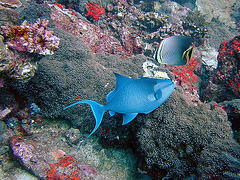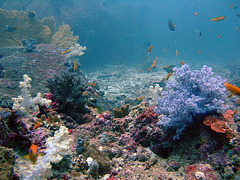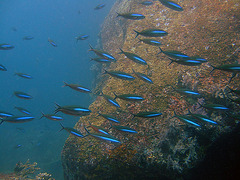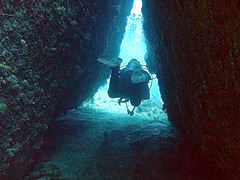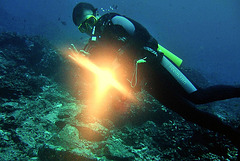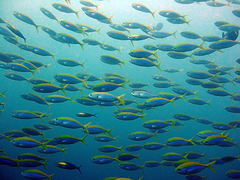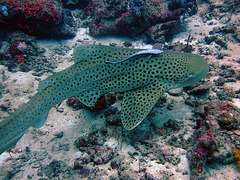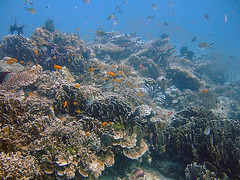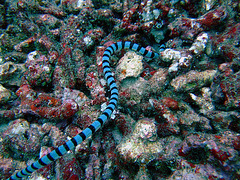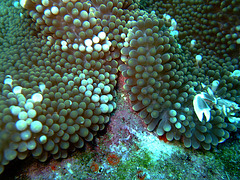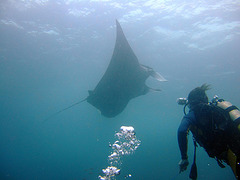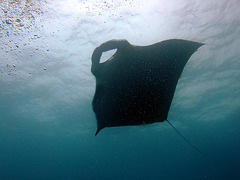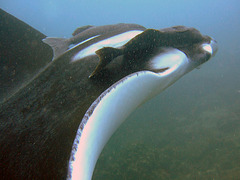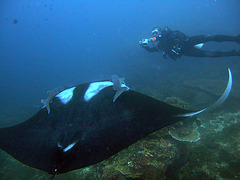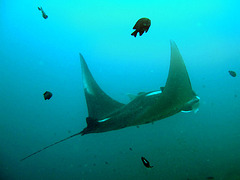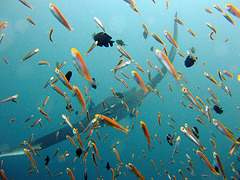
Diving at the Similan islands
When I start this album from our diving tours to the Similan islands I'd like to show my underwater photos captures with a simple FUJI FinePix F31fd pocket camera usually designed for lady handbags. Its an evidence that even with a small low-cost pocket photo camera you can shoot acceptable pictures underwater.
The necessary UW housing also comes from FUJI and was a quite inexpensive equipment to…
(read more)
Brilliant blue doctor fish
Colorful soft corals
| |
|
|
Unlike stony corals, most soft corals thrive in nutrient-rich waters with less intense light. Drifting over this gloriously colorful corals is always an unforgettable experience.
More neon fusilier fishes
| |
|
Bluestreak fusilier fish
| |
|
|
Also known as blue-dash fusilier, dark-banded fusilier, bartail fusilier and neon fusilier which are close relatives of snappers, but are much smaller and more slender.
Seen in large schools along deep reef drop-off's. They varies in color from blue to red with night and day.
The dive through a tunnel
| |
|
|
At Similand island Nr. 7 called Hin Pusa is a dive place called the Elephant head.
The site is named after an unusually shaped rock that juts out of the water just southwest of Koh Similan. The huge boulders that form Elephant Head Rock create daring swim-throughs, arches, caverns, gullies and tunnels.
One of my favorite diving places of all but due the heavy current it is a dive place for advanced and experienced divers only.
Night dive
| |
|
|
At every dive tour we organize two, three night dives after sunset. The organism coming out in the evening is different then the UW animals watching during the day dives.
Gold band fusilier fish school
| |
|
|
Goldband fusiliers grow to 21 cm. They are a non-migratory fish, found during the day moving in schools at depths between 5 and 35 metres among coral reefs, seagrass, along outer reef slopes and around pinnacles in deep lagoons. Its always a phantastic experience to observe the fish school passing us.
Suckerfish are sharks best friends
| |
|
|
|
Remoras (suckerfish) are commonly found attached to sharks and became the name as "shark sucker".
Drift dive over a coral reef area
| |
|
|
On of the most exciting diving experiences are the drift dives. We just jump into the water and dive down to 20 meters. The current let us fly over the colored coral banks from the starting point to the edge of the bank without moves with the fins.
Acalyptophis peronii sea snake
| |
|
|
|
This species reaches a length of about one meter and is very toxic, people say as poisonous 30 times the cobra toxic. But the snake never is aggressive to divers and there a rare fatal cases that sea snakes harmed the humans.
Sea Anemones
| |
|
A sea anemone is a polyp attached at the bottom to the surface beneath it by an adhesive foot, called a basal disc, with a column shaped body ending in an oral disc. Most are from 1.8 to 3 centimeters in diameter, but anemones as small as 4 millimetres or as large as nearly 2 metres are known.
There is a crab on the right side caught by the anemones.
Manta ray behind the fish swarm
| |
|
|
|
These harmless rays have a short tail without a stinging spine. They are very acrobatic; they can even leap from the water. They are graceful swimmers and swim by moving their pectoral fins up and down.
One more photo from the manta ray
| |
|
During our dive near Koh Tachai we were surrounded by perhaps ten of fifteen mantas showing their performance. It seems very clear, that the mantas have fun to play with us divers, because they often return very close to us and do not desapear.
The manta underneath the surface
| |
|
|
|
Some manta rays swim to the surface and turning around during our security stop in 5 meters. It makes diverting the resting time.
Close to mantas head
| |
|
|
|
Nearly every time the manta ray carries two or more cobia fishes who use the manta for a free ride on its backside of the head. Many people believe that the cobias eat the parasites out the skin from the mantas, but they only suck on the head for a free transportation.
The mantas cannot shake off the uninvited freeloader, but we can do it - and the manta likes it.
The manta ray ready for a photo shoot
| |
|
|
|
Mantas like the present of us divers but shout never been touched or ridden. The surface of the body is covered with a film for their own protection against any infects.
The ray is mostly bugged with two Cobia fishes on the wings which are free riders.
The ray cannot remove them by itself but is very happy if we do it.
Manta ray the divers friend
| |
|
|
|
Fishes in different sizes
| |
|
|
|
The small fish swarm of barbs in the foreground in ration to the huge manta ray with its wingspan of more than three meters.
Jump to top
RSS feed- Latest items - Subscribe to the latest items added to this album
- ipernity © 2007-2024
- Help & Contact
|
Club news
|
About ipernity
|
History |
ipernity Club & Prices |
Guide of good conduct
Donate | Group guidelines | Privacy policy | Terms of use | Statutes | In memoria -
Facebook
Twitter

